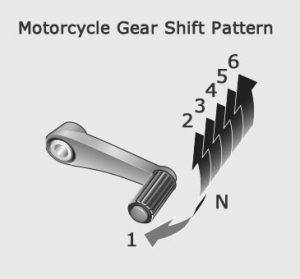Using Motorcycle Gears
One of the more challenging aspects of riding a motorcycle is using the gears, or more specifically changing up and down gears.
To change up and down gears, coordination is required between the clutch which engages or disengages the engine, the throttle which revs the engine and provides power from the engine and the gear selector. With a little practice however, it’ll soon become second nature.
Essentially, if you pull the clutch lever fully in using your left hand, the engine is disengaged so you’ll not go anywhere. If you release the clutch lever and you are in gear (not neutral), the bike will move forward.
If you haven’t done so already, you’ll need to gain an understanding on the gear selector lever on your specific motorcycle.
How Many Gears Does a Motorcycle Have?
The amount of gears that a motorcycle has varies as it depends on the particular make and model. Smaller low powered motorcycles may only have 4 gears, whilst larger modern motorcycles may have 5 or 6 gears.
Motorcycle Gear Shift Patterns
You’ll need to use your left foot to operate the gear lever to select 1st gear for moving off and higher gears as you gain speed. Before operating the gears, you should fully pull the clutch lever in. The typical gear shift pattern is as follows in the diagram.

Using the Motorcycle Clutch
The motorcycle clutch is operated using your left hand. Use all four fingers whilst operating the clutch to avoid the hand slipping off. When the lever is fully pulled in, the engine is disengaged and so the clutch can be squeezed in as quickly as you like (think the engine has been disconnected from the wheels). When the clutch is fully released, the engine is engaged (engine is connected to the wheels).
At some point between the clutch being disengaged and fully engaged is the biting point. The motorcycle clutch biting point is where clutch effectively begins to connect the wheels to the engine and if this is done to quickly, it may result in a sharp jolt of the vehicle. It’s important then to release the clutch slowly until you understand where the bite point area is within the working travel of the clutch.
When you gain more experience, you will only need to squeeze the clutch in just past the biting point and not all the way to the grip. Motorcycle clutch biting points vary in location depending on the particular make, model and how much wear the clutch has had.
Changing up a Gear
Changing up a gear on a motorcycle is required when the motorcycle is moving at a higher speed and when the engine is moving at a higher speed (revving faster). There’s no specific time that can be said for when to change up a gear as each motorcycle is different, plus it also depends on whether you are riding up or down a hill or on a level surface.
As you increase speed, listen to the engine as this will help you determine when you should change up. If the engine is revving high, it will increase fuel consumption and also increase stress / wear on the engine. To change up a gear, you should:
- Disengage the clutch by pulling it towards you whilst also closing the throttle
- Select the next higher gear by using the toe of your left foot and allow the lever to naturally fall back in place
- Now smoothly release the clutch lever whilst also opening the throttle
Use this same method each time you intend on changing up a gear on your motorcycle.
Changing Down a Gear
You’ll also need to practice changing down gears on your motorcycle. There are a few reasons why you will need to change down a gear. These are:
- If you are in too higher gear for the speed you’re doing, the engine will not provide you with enough power to accelerate, so you will need to change to a lower gear to match the slower speed you are traveling.
- Traveling uphill requires more engine power and you may need to change to a lower gear to gain this power
- If traveling downhill, changing to a lower gear enables your motorcycle maintain a steady speed rather than increasing speed (when throttle is closed). This is called engine braking.
- If you need to accelerate more quickly, for example to overtake another vehicle, changing down followed by increased open throttle will provide more power from the engine
To change down gear you should:
- Close off the throttle and pull in the clutch lever simultaneously
- Now select the next low gear by using the toe of your left foot to push down on the gear selector
- Finally release the clutch lever smoothly and open the throttle accordingly
Coasting
Once you have changed gear, it’s important that you fully release the clutch as soon as is safely possible. Keeping the clutch pulled in for too long is called coasting and can be potentially dangerous. For further information, see:
For related information, see: